Steve and Jemjahn go to Thailand, 2003
5. Jem's Old Home in the Village
10. Impressions of the Village
22. Thai People, My Impressions
11. The Mall in Korat
During
the Vietnam War, America had many soldiers and airmen stationed in Korat.
Iíll always remember it for having almost killed me, of hypothermia, of
all things, coming back to Bangkok on my motorcycle and getting caught
in a rainstorm at
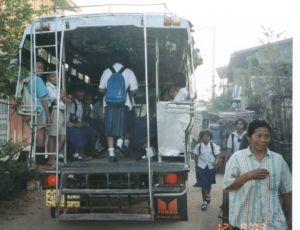 night in the hills. Today, Korat is the largest city
of the northeast, and the third largest city of the country. You might
see it on a map as Nakhon Ratchasima; same place.
night in the hills. Today, Korat is the largest city
of the northeast, and the third largest city of the country. You might
see it on a map as Nakhon Ratchasima; same place.
I had remembered Korat as a sleepy upcountry town. Thereís no doubt now itís not sleepy. Itís a modern city, and easy to see why a good number of American expatriates have chosen to retire in or around it. It has about all the amenities of life you might need.
Koratís higher elevation and its distance from Bangkokís traffic
and industry bring a better climate and cleaner air. Until the 3-wheel
samlors start up, anyway.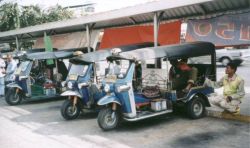
One morning we all piled into the pickup truck: Jem, her sisters Sangjahn and Jang, Sangjahnís husband Samahn, and me. Putting some mats and cushions in the back of the pickup, which had a cloth top to shade the sun, the two sisters and I were comfortable if not safe. The plan was to drop me off at The Mall for a couple hours while the family did some shopping, mostly for fresh vegetables.
Iíd read some articles about The Mall in the Bangkok Post the last few days. What I was most interested in (but never got to see, as it turned out) was a new section on computing equipment.
Apparently there are about a half-dozen ďThe MallsĒ in Thailand. Iíd guess the ones in Bangkok are better than Koratís, but it would be hard to see how. Even a mall-avoider like me would have to admit this one is an impressive, attractive example of mallus horribilus.
Not necessarily an asset, but itís huge. Three or four stories high with, Iím guessing, a basement for parking, it also sprawls horizontally like an amoeba.
Walking
along in the artificial air-conditioned climate, you stumble into a
kiddie arcade thatís as big as anything at a fairground, with bumper
cars, tracked rides, video games Ö a child could spend all day there and
not enjoy the same attraction twice.
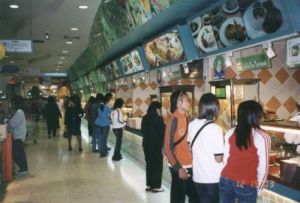
All that running around makes your children hungry, so you enter a large food court, one vendor after another selling wonderful Thai dishes at reasonable prices. Example: large bowl of noodles-and-pork soup: 30 baht, or 75 cents. Jem gave the food her approval, and when it comes to food her standards are high. (Fortunately, when it comes to husbands, sheís a lot more forgiving.)
An interesting payment system: you buy ďfood moneyĒ coupons at kiosks to use at the food stalls. Not sure why this is better than paying for your food directly. To prevent food workers from handling money? To prevent food workers from skimming the cash register? Never did learn the answer.
Now that your kids are exhausted from the playground and youíve girded your strength in the food court, itís time to shop. In addition to many small store fronts selling common household items, I also saw:
|
a supermarket (a recent innovation to Thailand, where shopping for food is still mostly done at traditional markets | |
|
a hardware store similar to Home Depot (in fact called Home Pro) | |
|
an indoor car show, complete with a couple dozen new cars by many manufacturers, to include attractive young women dancing and posing around the cars |
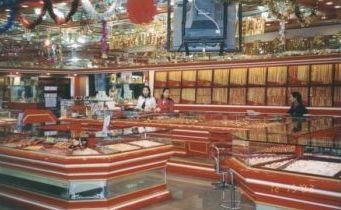 You
also have many small shops selling their own unique wares, such as
furniture, books, music/videos, and clothes. Sometimes theyíre grouped
together, as were the three gold jewelry shops, one pictured at left.
You
also have many small shops selling their own unique wares, such as
furniture, books, music/videos, and clothes. Sometimes theyíre grouped
together, as were the three gold jewelry shops, one pictured at left.
Why and how do they compete with their competition so nearby? Ah, the mysteries of free enterprise.
This The Mall had a large waterfall outside at the front door, and another impressive one inside as part of a jungle scenario.
I donít know how the other The Malls are. This one looked in excellent condition, to include the public bathroom I used, as if it had opened just a few days earlier.
Iím reminded of a similar shopping complex in Seoul I went to in 1989. It was also fairly new, but it seemed dark, cold and cheerless, a reflection maybe of the winter day, but I doubt July would improve it much. Sloppy construction was everywhere apparent. The Mall in Thailand, on the other hand, looked as if it could be in Atlanta: high ceilings, plenty of light, quality displays and careful construction.
Which makes me wonder: how can the place possibly succeed?
I
didnít see many shoppers with bags in their hands. In most shops, there
were more clerks than customers.
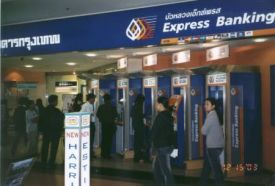
The World Almanac for 2001 (about when The Mall was built, Iíd guess) shows the per capita income in Thailand as $6,100. In comparison, per capita income in Texas, to use a representative American state, was $26,525.
A Bangkok Post article reported a labor dispute in Tak, a rural province. Workers at Nasausas Apparel Company went on strike (10 December 2003) because they were getting only 55-59 baht per day (about $1.50), and wanted a minimum wage of at least 133 baht per day (a little more than $3). A few days later, all the workers were fired and replaced.
So The Mall has to succeed with shoppers, many making just $3 for a full dayís work. It would be a success in Dallas, Austin, San Antonio or Houston. But Korat?
Yet there it is. Somebody with a lot more money and business acumen than me has determined it will be a good return on investment. Who am I to argue?
next: Gordon and Pu